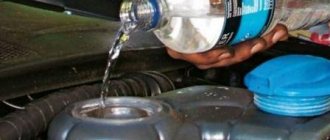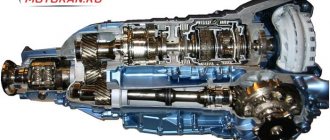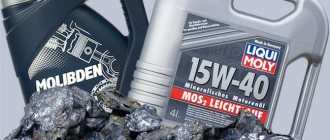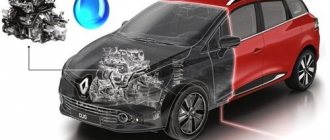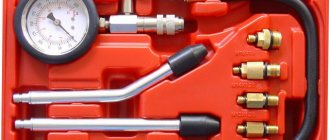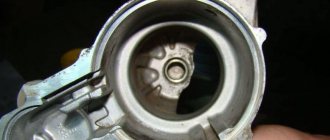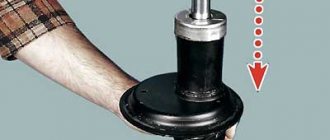Should I flush the engine with diesel fuel when changing the oil? Is it possible? Taking care of your iron horse is the responsibility of every “rider”. To keep the heart of your car beating smoothly, it needs to be checked, lubricated and cleaned periodically.
Everyone knows that to lubricate an engine, they use oil, which gently, and sometimes not very carefully, envelops the surface of the engine parts and washes its components. Using additives, strive to protect, clean, remove scale, fill uneven surfaces, and solder, if required. But sooner or later, the lubricant runs out of life. It turns into a thick, dirty ointment that no longer helps as much as harms the engine. In this regard, the car owner must monitor its condition, change it and flush the engine itself.
Before answering the question of whether it is possible to flush the engine with diesel fuel when changing the oil, let’s decide whether this should be done at all.
Let's weigh the pros and cons
Of course, since you are reading the article, you are a caring owner. And at a minimum, try to extend the life of your engine - this will save money in the future on buying a new car or replacing an old one. But is the washing process really necessary? Will it do any harm?
Cases when major cleaning is necessary:
- The motor has considerable mileage. During long-term uninterrupted operation, clots consisting of tarry deposits, scale on the walls, and slag accumulate inside the power unit. The longer a car is used, the more consumables it has. If you want to extend its life, then rinse it.
- If you don’t know what’s in the box and don’t want to risk mixing possibly incompatible liquids
- In cases of change of manufacturers or types of fuels and lubricants. Without flushing, at best, you will get a lubricant with average properties that will behave unpredictably under extreme conditions. At worst, a breakdown of the lubrication system or the internal combustion engine as a whole.
- If there is a suspicion that cooling components have gotten into the oil when using the car. As a result of breakdowns of individual components.
- After a major overhaul of the “heart”. Due to such work, small particles of used lubricants or scattered scale may remain inside. Without flushing, they will worsen the passage of lubricant through the channels intended for this purpose.
- Using the machine for a long time under extreme conditions: low or high temperatures outside, high speeds, dusty or polluted operating environment
- Inside is a turbocharged engine, which is especially sensitive to dirty lubricant and can be seriously damaged. For such models, a “major bath” is required much more often - every 3-5 thousand km.
Why is a heavy shower harmful to the engine?
On the other hand, there are a number of contraindications. Mainly depending on the cleaning procedure itself.
Engine washing is carried out in 3 stages:
- Removing used grease
- Filling the cleaner
- Draining the cleaning liquid
As a result of using a “diluted” lubricant, we have:
- Fast resource depletion
- Poor performance of the lubricating function
- The emergence of an emulsion
- Foaming lubricant and other “delights”
- Reducing viscosity is the main characteristic that a car enthusiast relies on when filling a new petroleum product.
Washing methods
If you are asking whether it is possible to flush the engine with diesel fuel when changing the oil , then you probably know other methods of cleaning the engine. There are actually several of them.
Five minutes . A special composition that is added to the old lubricant before the first stage. Start the engine for a few minutes and allow the mixture to pass around the entire circle. Manufacturers claim that in such a short period of time, the “decoction” can remove all excess from parts and, together with the used oil, flow out. However, there is no laboratory evidence that this is exactly what happens. And the short period of time spent inside is very alarming.
Flushing liquid . Some of it remains inside the motor and mixes with the new lubricant, changing the desired properties. The effect of its use can be unpredictable.
Flushing oil . Car enthusiasts, trying not to harm their engine, first wash it with a cleaning fluid. And then they run cheap oil through the engine, purchased specifically to soften the effect of it. Although the oil remains in the unit, it does not affect the new lubricant too much.
All previous options are inferior to long-term flushing in terms of residence time inside the power unit. It is poured inside before changing the flammable petroleum product and drives 50-100 km. During this time, the special properties of such a “brush” make it possible to dissolve carbon deposits and deposits without harming engine parts. Since they do not contain chemical solvents, there is no need to worry about seals, gaskets and filters. But a significant disadvantage is the high price and the possibility of fakes.
At a car service center they may offer the option of washing with a vacuum pump . However, its power and technology are often not enough to clean hard-to-reach corners of the power unit.
What to wash with?
Clogged lid
Motor oils contain additives with detergent, anti-corrosion, antioxidant, and extreme pressure properties. They are not prone to the formation of deposits and dirt. Many of them are retained by the filter, and some are discharged through the crankcase drain hole. Deposits accumulate if different brands of oil are used.
That is, the remaining contaminants, mixing with the engine oil, precipitate, forming deposits. Frequent overheating of the engine leads to the formation of these, causing decomposition of the motor fluid. As a result, coke deposits that are difficult to wash off and sometimes cannot be removed appear on the inner walls of the block. The situation comes down to the rapid depletion of the lubricant life.
What's better
GZox Flushing Oil
It is preferable to use flushing fluids for the engine. Their range differs in additive components.
- FlushOil− is poured after draining the waste. It is recommended to operate the car for 50÷500 km before filling with new oil.
- EngineFlush− is used after removing the old one. Can be added to the oil in the pan. It is advisable to let the machine idle for a few minutes.
- Cleaning additives are poured into the engine 3-4 days before replacement. They have the ability to penetrate everywhere, splitting and dissolving sludge and slag.
Result of using flushing fluid
Meanwhile, there is no consensus regarding flushing oils. Doubts are raised by aggressive (alkaline) additives, which unsatisfactorily clean coked deposits of dirt within a few minutes of engine operation. And aggressive compounds lead to corrosion of rubber seals.
Basis for flushing the internal combustion engine
The procedure for washing with kerosene or diesel fuel comes from the Soviet period. This well-known method is used among car enthusiasts to clean units produced in our country.
This method of washing still gives rise to numerous questions and disagreements, because car owners cannot come to a consensus on how useful this procedure is.
Opinion of experienced car owners: flushing the internal combustion engine with diesel fuel or kerosene helps to increase the service life of engine oil components, since these are excellent petroleum products that can easily replace special flushing mixtures.
The cleansing operation with these means allows the internal mechanisms to return to their original appearance. Petroleum products can rid the power unit of accumulated carbon deposits and dirt and clean the circulation paths. This is how experienced motorists see cleaning an internal combustion engine.
Flushing the engine with kerosene (diesel oil) - benefits and harms
True, similar methods were used and were relevant several decades ago, since the number of car service points was extremely low. Currently, modern cleaning technologies are equipped with computer devices, which allow you to quickly and accurately flush the internal combustion engine.
Today, the method of flushing the engine with these compounds is becoming a thing of the past, since in addition to the benefits of the procedure, you can also get harm.
Over time, engine designs and lubricants for automobiles undergo constant changes. If the driver nevertheless decides to wash the new power unit with kerosene or diesel fuel, then he will immediately say goodbye to its warranty.
The only rational option for such washing is considered to be a situation where the power device is completely dismantled and disassembled in parts.
Despite the legends that surround these oil flushing products, they will not completely cope with the task. The engine system always contains hard-to-reach areas where contaminants are densely located.
Therefore, if kerosene penetrates into this area, even in small quantities, the oil product will remain there. And this is fraught with consequences.
If the owner of the car fills in a new portion of the lubricating mixture, the remaining kerosene will be mixed with this motor fluid. As a result, the lubricant will lose some of its beneficial properties.
Modern service – is it worth experimenting?
A huge number of service stations, as well as special oil change points, can provide any car owner with quality service with a selection of individual products. To do this, you will not need to bother with the problem of draining the used oil and the method of filling it to replace it.
Also, most likely, the service staff will offer to wash the engine with special detergents, but this is not necessary and only you decide whether to do this or not. Of course, all these services cost money, but the desire to save money can turn against you.
We recommend: The dashboard of the domestic “Seven” and its features
During the Soviet Union, when cars were just beginning to be widely used, there was nothing like this. Each owner, in separate garages, independently maintained and repaired his car, often using improvised means. It was from that time that the fashion of washing the engine with diesel fuel, and not only that, began. Kerosene or solvent was also used for these purposes.
Nowadays, when there are a huge number of tools specifically designed for this, using grandfather’s methods is simply illogical; why complicate life for yourself and your car. Also, one cannot be completely confident in the positive reaction of modern machines to such manipulations.
Maybe representatives of the VAZ-ZAZ era withstood various “bullies” of their owners, after which they even worked properly for some time, but today’s foreign cars, with their electronics and more advanced systems, will definitely not thank you after committing such actions.
And our grandfathers had no other choice; the quality of the same motor oil, which is used today by individual motorists for flushing, then left much to be desired, so we had to use kerosene and diesel fuel. If any foreigner knew that a similar trend is still used somewhere, he probably wouldn’t believe it. But this is true, although most drivers consider this method of cleaning the internal space of the engine to be an unjustified risk.
Thus, we came to the conclusion that in our time it is better NOT TO EXPERIMENT and trust existing technologies.
Engine flushing stages
The operation of cleaning the power unit is carried out according to the following procedure:
- Before draining the used motor oil, it is necessary to prepare a container for draining in advance; it should be twice the volume of the drained oil, since kerosene must also fit into the tank.
- The flushing agent must be poured sharply and abundantly so that it flows into all accessible areas of the engine and rids the system of the previous oil composition. It is extremely important that the drain plug is open. It is necessary to drive 2-3 liters of kerosene with a similar flow.
- Close the drain hole with a plug and add a certain volume of kerosene to the internal combustion engine, which is equal to the amount of a new portion of the lubricant when replacing.
- We start the engine, after which we need to rev it up a little. The gas pedal must be pressed to the floor, since the quality of cleaning the power unit depends on this. The procedure is necessary so that the pressure in the system increases, and the flushing agent cleans the parts more effectively. However, you will have to ensure that the installation does not warm up to operating temperature.
- We drain the flushing agent and carefully inspect it for the presence of oil residues. If there is a large amount of motor lubricant in the process, then the cleaning procedure must be repeated.
- When the cleaning operation is completed and a fresh portion of lubricant has been added to the internal combustion engine, it is necessary to start the power unit. It is necessary to let the engine run for a while so that any remaining oil residues are completely dissolved in the new composition. It’s a good idea to test the vehicle’s behavior while driving.
Cleaning the motor system in this way only gives a certain effect. For example, the “smacking” knock of the device, which is responsible for automatically adjusting the gap between the valves and the camshaft, is reduced.
It can also be noted that the lubricating mixture will remain transparent longer. But it is also possible that after undergoing the flushing procedure, some difficulties may arise with starting the engine.
The thing is that the oil products in question do not have the necessary friction effect, so the starter has a problem with cranking the crankshaft, or it will create a load on the engine mechanisms.
Flushing the engine with diesel fuel before changing the oil is considered an old, but proven and practical method of cleaning the engine. It’s completely in vain that many modern car enthusiasts laugh at eccentrics who use this old-fashioned method.
Flushing the engine with diesel fuel will restore a second youth to the entire oil system.
Flushing with diesel fuel, i.e. diesel fuel, gasoline engine allows you to get rid of dirt and scale without the use of aggressive substances, and therefore without worrying about system elements that may be damaged by aggressive influence. Flushing the engine with diesel fuel allows you to restore a second youth to the entire oil system in a simple and cheap, and most importantly, safe way.
Pros and cons of diesel fuel as a flushing fluid
Indeed, one of the advantages of diesel fuel in comparison with special means is the pricing policy. Flushing the engine with diesel fuel before changing the oil will be much cheaper than carrying out this procedure using purchased emulsions. The second argument in favor of diesel fuel is its use in all CIS countries for cleaning engines of domestically produced equipment, as well as its applicability for engines of special equipment. The effectiveness of this method is proven by the large number of domestically produced cars on the roads at the present time, which perfectly perform their functions despite their advanced age.
But the following fact casts doubt on the benefits of diesel fuel for the engine. Many users explain the effectiveness of diesel fuel when flushing the engine before changing the oil by the fact that it is actively used to clean engine elements during major repairs by professionals. And this is true, diesel fuel actively cleanses the elements of scale, dirt and sludge. However, opponents of the theory argue that when cleaning parts during a major overhaul, these components are not only affected by diesel fuel, but also a significant mechanical force is applied, due to which a positive result is achieved.
In addition, many experts note that when flushing the engine, diesel fuel does not break down the scale on the parts, but acts by peeling it off from the internal surfaces. Since it is almost impossible to completely remove these particles during the washing process, some of the coarse components will remain in the engine, and when oil is added, the particles will freely circulate through the system, causing damage to it and blocking small passages, thereby causing oil starvation of individual engine components. Additionally, doubts about the effectiveness of diesel fuel in cleaning the power unit are caused by the effect of the liquid on oil seals, gaskets and seals. Diesel fuel can cause their deformation, which will affect not only the functionality of the motor, but also its performance characteristics, and can cause its premature failure.
An impressive list of both positive characteristics of diesel fuel as a flushing fluid and negative factors makes you wonder whether it is possible to flush the engine with diesel fuel when changing the oil. There is no clear answer to this question. In practice, over the years of its use, diesel fuel has earned popularity in relation to the engines of domestically produced cars with significant mileage. Some owners of used foreign cars also actively use this method of cleaning the power unit and confirm its effectiveness. As for new or warranty cars, foreign cars with low mileage, engines of modern modifications, here the opinion of professionals is unequivocal - such a procedure is strictly prohibited, since it may not only not produce results, but also harm the engine. In addition, even for old cars, the procedure should be performed only when the need arises, but not at every oil change.
Necessity of the procedure
Engine oil markings.
During the operation of the vehicle, tar deposits and scale accumulate on the walls of the channels in the oil system of its engine, which can significantly impair oil circulation, reducing the effectiveness of the cooling function. The problem increases significantly when using low-quality oil, when such deposits, acquiring significant volumes, can practically block the oil channels. After 10,000-15,000 km, the oil is usually changed. However, if the car was operated in difficult conditions and with a poor-quality composition, then filling in new oil without cleaning the channels from dirt and interference can simply become a useless exercise.
Before filling in a new oil composition, it is recommended to flush the engine in the following cases: when switching to another type of engine oil; when filling for the first time and not knowing the brand of liquid previously filled; if antifreeze or other coolant gets into the oil during vehicle operation; after engine overhaul.
Features of the washing procedure
The operating principle of the engine lubrication system.
The main task of flushing the engine before adding new oil is to completely clean the system of previous fluid and accumulated dirt or carbon deposits. To solve this problem, it is necessary to use compositions that can dissolve solid growths, the remains of tarry deposits and the remains of the old composition. To clean the engine, 2 main methods are used: introducing special additives into the oil before draining it or pouring flushing fluid after draining the old composition. Modern means for this purpose cope well with the task, but, firstly, they are quite expensive, and, secondly, they have increased chemical aggressiveness, which can have a destructive effect on engine parts.
How to rinse the engine with diesel fuel before changing the engine oil
Flushing the engine before changing the engine oil is a procedure that drivers carry out for various reasons. The engine is flushed to remove heavy contaminants from the lubrication system, during the transition from one type of oil to another, as a result of malfunctions that intensively contaminate the oil system, etc. Note that there are several ways to clean the internal combustion engine. You can use special flushes into the used oil (the so-called “five-minute flushes”), add flushing oil for a short period of time, or even drive some flushes for several tens of kilometers in moderate mode.
In parallel with this, for many drivers, flushing the engine oil system with diesel fuel remains the preferred option. The main argument is that for such washing there is no need to separately purchase ready-made washing compositions, which saves money. In this article we will look at this cleaning method in more detail, and also talk about the advantages and disadvantages of such a solution.
Read in this article
Carrying out the filling procedure
The engine is flushed with diesel fuel after draining the used oil. This draining is carried out in the standard way through a hole in the oil pan. To do this, the car is installed on an inspection hole or overpass. Using the appropriate wrench, loosen the drain plug. After a container is placed under it, the plug is unscrewed by hand and sharply pulled to the side so that the oil stream is directed into the container. Used oil must be completely drained from the system.
The next step is to remove the oil filter, which is usually unscrewed by hand. If necessary, the appropriate key is used. After this, a temporary oil filter is installed. It is only needed for the engine cleaning period, so it is recommended to choose the cheapest option.
The washing procedure is carried out in two stages. First, when the plug is removed from the drain hole of the oil pan, diesel fuel (a mixture of diesel fuel with oil or kerosene) is poured into the system with a sharp movement. The initial impulse of the priming jet is necessary to ensure gravity flow of the liquid throughout the system. The volume of diesel fuel poured is about 2.5-3.5 liters. The cleaner should pass through the oil system and flow out of the drain hole at the bottom. This ensures primary cleaning of the largest contaminants and residues of the old composition.
The next stage of washing is carried out with the plug closed, for which it is returned to its place and tightened manually. Diesel fuel is poured into the lubrication system in a volume equal to the usual amount of oil poured. After this, you need to start the car engine for a short time and drive it in the gas mode. The degree of cleaning of the system largely depends on this gas release from the engine. It is important to control the temperature - the engine should not warm up to operating temperature.
The engine is turned off and the drain plug is unscrewed again. All filled diesel fuel is drained while controlling the release of dirt. If pieces of dirt continue to come out along with the last drops of solvent, then the flushing operation is performed again (with the engine running). Similar procedures are carried out the required number of times. The duration is determined by the type of diesel fuel being drained.
Flushing stops when clean, transparent liquid begins to flow from the drain hole.
The engine flushing operation is completed by completely draining the flushing fluid. After which the drain plug is tightly screwed in with a key. The temporary oil filter is dismantled and a new high-quality oil filter is manually screwed in its place for operation under operating conditions. After all the manipulations have been completed, you can safely fill in new oil. Naturally, after filling in the new composition, it is necessary to carefully check the tightness of the entire system, and then carry out a test drive in the car.
How to wash the engine with diesel fuel or kerosene
In the event that you nevertheless decide to wash the power unit with diesel fuel, then it should be noted that this procedure is not complicated. Flushing the engine with diesel fuel before changing the oil is carried out as follows:
- It is necessary to prepare about 5-6 liters of pure diesel fuel/kerosene without impurities;
- Purchase 2 oil filters (one may be the cheapest);
- The engine warms up until it reaches operating temperatures;
- The used engine oil is drained and the old oil filter is removed;
- Next, you should fill in kerosene or diesel fuel, install a new (cheap) oil system filter;
- Then the engine should be started for a couple of minutes, slightly accelerated at idle to medium speed;
- Now you can turn off the car, since warming up the engine above 40-50 degrees with diesel fuel poured into the lubrication system is not allowed.
- After the internal combustion engine has cooled, the engine is started again and the procedure is repeated;
- Next, you can drain the diesel fuel, replace the oil filter and add fresh engine oil;
This is interesting: How to determine the condition of spark plugs by appearance
Now let's look at the procedure in more detail. Note that some drivers do not fill the engine with pure kerosene or diesel fuel, but additionally dilute the cleaner with fresh engine oil. In this case, you will need to prepare 2-3 liters of affordable mineral water.
- Before draining used oil from the engine, it is necessary to either prepare a pan of increased capacity or have spare pans. The fact is that after draining the flush, as well as a number of additional manipulations, in general, twice as much liquid (old oil and flushing) will drain from the unit.
- After draining the “working off”, it is recommended not to screw in the drain plug, but to pour several liters of diesel fuel through the engine. The flush must be poured into the oil filler neck sharply so that the diesel fuel passes through the unit under a certain pressure and washes away the remaining engine oil. To do this you will need 2-3 liters of kerosene. After this, you can screw in the drain plug, after which diesel fuel is poured into the engine in a volume that almost reaches the “max” indicator on the dipstick.
After draining the flush, replacing the oil filter and adding fresh oil, you need to take into account that the engine may be difficult to start. The fact is that diesel fuel washes away the oil film and also does not have sufficient lubricating properties. As a result, it is difficult for the starter to turn the crankshaft. After starting the unit, you need to let the engine run for some time at idle speed. At the same time, you need to listen to the operation of the engine, to exclude the occurrence of extraneous noise, knocking or other suspicious sounds. After this, you can start using the car as usual.
Summing up and conclusions
When washing the unit with diesel fuel, one small nuance should be taken into account. Unlike oil, diesel fuel is less viscous and does not provide the necessary adhesion to parts. When starting the engine during the washing process, minor problems with starting are possible - it may not start the first time.
Nowadays, various flushing compounds are offered for cleaning a car engine, but they are quite aggressive. A much gentler method is to wash the unit using diesel fuel. This method has been used for decades and has proven its effectiveness.
How can I flush a diesel engine?
As a rule, to prevent wear of a diesel engine, it is cleaned with specialized flushing oil, which creates a film on the parts. There are also specialized detergents for this type of engine. They effectively clean the engine and prevent loss of performance.
The most common are the following compositions:
| Name | Properties | Average price category |
| ZIC FLUSHING OIL | Cleaner well suited for diesel | No more than 500 rubles |
| Liqui Moly | Universal detergent, equally suitable for petrol and diesel engines | No more than 1000 rubles |
